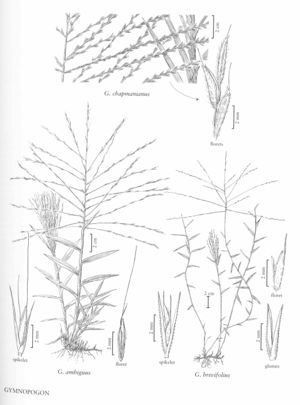| Taxon | Illustrator ⠉ | |
|---|---|---|
 | Gymnopogon brevifolius Gymnopogon ambiguus Gymnopogon chapmanianus | Linda A. Vorobik Linda A. Vorobik Linda A. Vorobik |
Plants usually perennial; often cespitose in appearance, rhizomatous. Culms 10-100 cm, erect to decumbent, simple or sparingly branched. Leaves cauline, evidently distichous; sheaths often strongly overlapping; auricles absent; ligules 0.1-0.5 mm, membranous, ciliate; blades linear to ovatelanceolate, lacking midribs. Inflorescences terminal, panicles of spikelike branches, these subdigitately or racemosely arranged, usually strongly divergent to reflexed, sometimes naked basally, spikelets borne singly. Spikelets widely spaced to slightly imbricate, appressed to the branches, shortly pedicellate, laterally compressed, with 1-2 (4) florets, only the lowest 1 (2) floret (s) bisexual; rachilla extensions present, usually with a highly reduced, sterile floret (s); disarticulation above the glumes, florets falling together. Glumes subequal, usually exceeding the bisexual florets, narrow, acuminate, 1-veined; lemmas of bisexual florets 3-veined, midveins prominent, apices minutely bidentate, usually awned from between the teeth, rarely unawned; anthers (2) 3. x = 10.
Distribution
Del., D.C, W.Va., Fla., N.J., Tex., La., Tenn., N.C., S.C., Pa., Va., Puerto Rico, Virgin Islands, Ala., Ark., Ill., Ga., Ind., Md., Kans., Okla., Ohio, Mo., Miss., Ky.
Discussion
Gymnopogon, a genus of around 15 species, extends from the United States to South America, with one additional species ranging from India to Thailand. Three species are native to the Flora region. Gymnopogon is most likely to be confused with Chloris, but its species differ from most species of Chloris in having a more highly reduced, sterile floret at the end of the rachilla extension and in its distichous leaves.
Selected References
Key
| 1 | Plants with elongate rhizomes; panicle branches naked for at least 1/3 of their length | Gymnopogon brevifolius |
| 1 | Plants with short, knotty rhizomes or cespitose with a knotty base; panicle branches naked for less than 1/3 of their length, often spikelet-bearing to the base. | > 2 |
| 2 | Lemma awns 4-12.2 mm long | Gymnopogon ambiguus |
| 2 | Lemma awns 0-2.2 mm long | Gymnopogon chapmanianus |
"decumbent" is not a number.